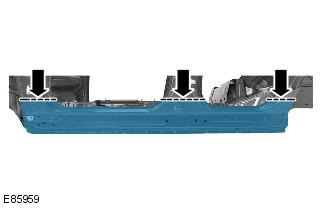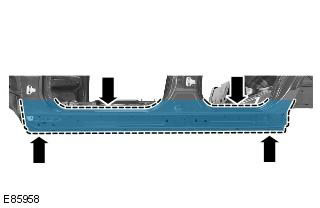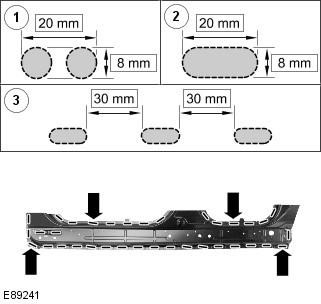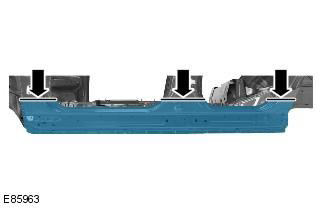CAUTION: The bottom trim panel must be MIG brazed to the internal reinforcement of the bottom trim panel, which is made of DP600 steel (duplex steel). MIG welding / spot welding must not be used.
NOTE: The bottom rail panel is serviced as a separate weldable panel.
Removing
1. In combination with the bottom trim panel, replaces:
- front bumper cover
- Front fender
- Front door
- Backdoor
2. For more information regarding this repair procedure, see: For more information, refer to the chapter: Body and frame (501-26 Body Repairs - Vehicle Special Information and Approval Checks, Description and Operation) / Standard techniques used at the service station (100-00 General information, Description and principle of operation).
3. Remove the fender.
4. Remove the front door. For more information, see chapter: Front door (501-03 Lockable body elements, Removal and installation).
5. Remove the back door. For more information, see chapter: Tailgate (501-03 Lockable body elements, Removal and installation).
6. Remove the front wheel. For more information, see the chapter: Wheel and tire (204-04 Wheels and tires, Removal and installation).
7. Remove the rear wheel. For more information, see the chapter: Wheel and tire (204-04 Wheels and tires, Removal and installation).
8. Left side: Remove the hood release handle.
9. Remove the front seat. For more information, see chapter: Front seat (501-10 Seat, Removal and installation).
10. Remove the floor console. For more information, see the chapter: Floor Console (501-12 Instrument panel and console, Removal and installation).
11. Remove a sealant of an aperture of a forward door.
12. Remove a sealant of an aperture of a back door.
13. Remove the panel of finishing of a doorway. For more information, refer to chapter: Front Doorway Trim Panel (501-05 Interior trim, Removal and installation).
14. Remove the top trim panel "IN". For more information, please refer to the chapter: Rack Top Trim Panel (501-05 Interior trim, Removal and installation).
15. Remove the bottom panels of finishing of the right and left rack "IN". For more information, please refer to the chapter: Rack Trim Lower Panel (501-05 Interior trim, Removal and installation).
16. Remove the panel of finishing of a back lateral part of a body. For more information, please refer to the chapter: Rear Side Trim Panel (501-05 Interior trim, Removal and installation).
17. Remove the interior trim of the right and left bottom trim panels.
18. Remove the lower trim panel outer molding.
19. Remove the interior trim of the rear panel.
20. Remove the rear seat cushion. For more information, see chapter: Rear seat cushion (501-10 Seat, Removal and installation).
21. Remove the front seat belt retractor. For more information, see chapter: Front seat belt retractor (501-20A Seat belt system, Removal and installation).
22. Remove the rear carpet section.
23. Loosen and set aside the front carpet section.
24. Remove the side impact sensor from the middle pillar of the body. For more information, refer to the chapter: Strut Side Impact Sensor (501-20B Secondary restraint system, Removal and installation).
25. Remove the side impact sensor from the rear pillar of the body. For more information, refer to the chapter: Strut Side Impact Sensor (501-20B Secondary restraint system, Removal and installation).
26. Loosen and lay aside the bulkhead's internal insulation.
27. Loosen and lay aside the wiring harnesses that run along the inside of the bottom trim panel.
28. Cut off the old panel at the junction with the rack "A", rack "IN" and rear side panel, leaving an allowance for the overlap of the new panel. Use the new panel for help.

29. Mill the weld points.

30. Separate the connections and remove the old panel.
Installation
1. Attach the new panel, align it and lock it in place, overlapping the old panel remaining on the vehicle.
2. Cut through the new and old panels at the post "A", racks "IN" and rear side panel where MIG butt joints are to be made.

3. Remove the new panel and the remains of the old one.
4. Cut holes in the new MIG braze plate.
NOTE: The holes for MIG brazing must be made according to the gaps shown in the illustration. Where this is not possible due to recesses in the panel, the hole should be made in place of the original spot weld.

5. Prepare the connecting surfaces of the old and new panels.
6. Attach the new panel and lock it in place. Check the reconciliation, if correct, go to the next step, if not, correct and check again before proceeding to the next step.
7. Tie butt joints.
8. Carry out MIG brazing.

9. Clean the tack welds.
10. Carry out MIG butt welding.

11. Clean all welds.
12. Reverse the removal procedure to install the appropriate panels and mechanicals.
Comments on this article